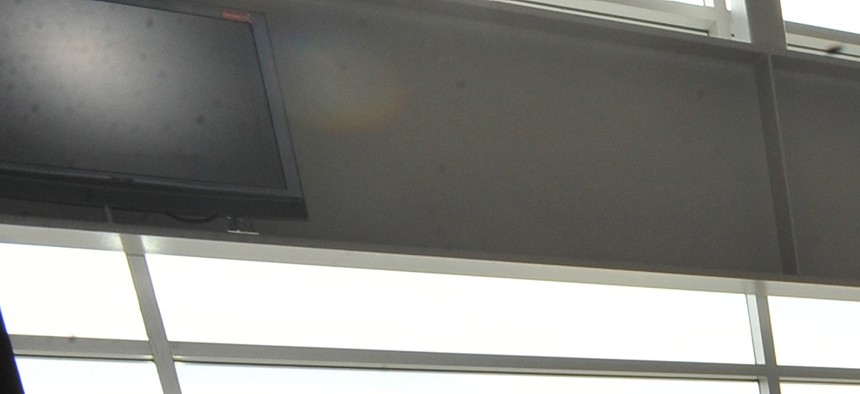
Job-seeking veterans and service members speak with a prospective employer at the Hiring Our Heroes DC job fair at Nationals Park on Dec. 5, 2012 in Washington. Larry French/AP Images for National Chamber Foundation
Veteran Unemployment Rate Drops, But Still Outpaces the Rest of the Country
Despite an overall jobless rate decline of nearly half a percentage point in April, recent vets are still having a harder time finding work than the general public. By Ben Watson
For the fourth year in a row, veterans are having a harder time than non-veterans finding jobs, though the percentage of recent veterans unable to find work is in decline, according to a report released Friday from the Bureau of Labor Statistics. But there remains a growing pool of Iraq and Afghanistan veterans whose unemployment rate still outpaces both their civilian counterparts and veterans of previous conflicts.
The unemployment rate for Gulf War II veterans—defined as those who served after Sept. 11, 2001—fell from 7.5 to 6.8 percent for the 12 months beginning April 2013. The non-veteran population, meanwhile, witnessed a bigger drop in unemployment over the same period, with last April’s 6.9 percent rate falling to 5.7 percent. New veterans have had a particularly tough go of the job market since the recession hit, with the unemployment rate spiking to its worst levels, edging close to 15 percent, in 2010 compared with just under 10 percent for the rest of the country during the same period.
“The good news here depends on where you place the goal posts,” said Derek Bennett, chief of staff for the Iraq and Afghanistan Veterans of America. So yes, he said, the unemployment rate trends downward for veterans. But with nearly 7 percent out of work, that’s more than 190,000 of the 2.8 million Gulf War II veterans who can't find work.
Each year the military separates between 240,000 and 360,000 service members, according to a 2013 White House report on measures to help veterans find jobs. Those numbers are expected to rise well into the millions in the coming years as the military looks to cut troop levels across the services to meet the fiscal challenges imposed by sequestration.
“There are some job skills a number of young veterans pick up during their time in the military that translate fairly well to jobs outside their branch of service,” Bennett said. Logistics and operations functions, for example, tend to be some of the easier—if not always lucrative—jobs vets land after serving.
But many led troops in combat, presided over millions of dollars worth of equipment, and served as leaders in other capacities, too, during their time in service. “So the question that I see,” Bennett said, “is it’s a downward trend, and that’s great. But thousands and thousands don’t have a job. And at end of day shouldn’t that number be zero with their qualifications?”
Last month, the White House announced the launch of a centralized website to help veterans and their spouses find work. In late 2011, the administration signed into law the Returning Heroes Tax Credit giving businesses as much as $5,600 to hire unemployed veterans and nearly $10,000 to hire veterans with service-connected disabilities. More than 50,000 certifications were given to employers nationwide in 2013, bringing in more than $1 billion for employers annually, according to the Labor Department. The law expired in January and has not been without its challenges as Congress hasn’t passed a comprehensive budget since 2009. Nevertheless, the jobless rate for young veterans has seen a steady decline since 2010’s unemployment high.
“The other part of this question of vets finding work deals with the size of companies hiring,” Bennett said. “There’s a certain size that seems to have worked best for veterans looking for work—banks, for example. Disney was successful at it. Large-capacity companies do it well, but they use software to screen through resumes. Mid-size companies have a harder time.”
Friday’s numbers, Bennett said, come from a group of people “already vetted by the government on some level. Over 80 percent of the country can’t enlist in U.S. military for various reasons. Yet these young folks have done that, and they’ve got job training that you would think would be highly desirable.” But the numbers, he said, just aren’t reflecting that opinion.
One key factor, Bennett said, can be found in the first step in the hiring process—the job interview.
“You have to talk about yourself and for some vets, that’s tough to do,” he explained. “For years they were worried about the team, not the individual.”
“One other surprising thing we’ve observed is female veteran unemployment tends to be higher and is up from where it was a year ago,” Bennett said. Despite suggestions that the female percentage is higher due to a possible increased likelihood of them having children to care for, he said it’s still too early yet to dig into precise causes. “All we can do is identify the trend and keep working with the Defense Department to come up with solutions.”